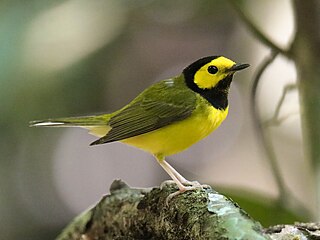
The yellow-rumped warbler is a regular North American bird species that can be commonly observed all across the continent. Its extensive range connects both the Pacific and Atlantic coasts of the U.S. as well as Canada and Central America, with the population concentrated in the continent's northern reaches during the breeding season and migrating southwards to southern North and Central America in the winter. It generally prefers coniferous forests or mixed coniferous-deciduous forests as its breeding habitat, while during the winter it can be found inhabiting more open areas such as shrublands that offer food resources. The yellow-rumped warbler is primarily insectivorous, though the species does eat fruits such as juniper berries as well, especially in winter.

The Cape May warbler is a species of New World warbler. It breeds in northern North America. Its breeding range spans all but the westernmost parts of southern Canada, the Great Lakes region, and New England. It is migratory, wintering in the West Indies. This species is a very rare vagrant to western Europe, with two records in Britain as of October 2013. The English name refers to Cape May, New Jersey, where George Ord collected the specimen later described by Alexander Wilson. This species was not recorded again in Cape May for another 100 years, although it is now known as an uncommon migrant there.

The northern parula is a small New World warbler. It breeds in eastern North America from southern Canada to Florida.

The black-and-white warbler is a species of New World warbler, and the only member of its genus, Mniotilta. It breeds in northern and eastern North America and winters in Florida, Central America, and the West Indies down to Peru. This species is a very rare vagrant to western Europe.

The hooded warbler is a New World warbler. It breeds in eastern North America across the eastern United States and into southernmost Canada (Ontario). It is migratory, wintering in Central America and the West Indies. Hooded warblers are very rare vagrants to western Europe.

The pine warbler is a small songbird of the New World warbler family.

The prairie warbler is a small songbird of the New World warbler family.

The palm warbler is a small songbird of the New World warbler family.

Kirtland's warbler, also known in Michigan by the common name jack pine bird, or the jack pine warbler, is a small songbird of the New World warbler family (Parulidae). Nearly extinct just years ago, populations have recovered due to the conservation efforts of Phil Huber and the U.S. Forest Service. The birds require large areas, greater than 160 acres, of dense young jack pine for breeding habitat. This habitat was historically created by wildfire, but today is created through the harvest of mature jack pine, and planting of jack pine seedlings.

The yellow-throated warbler is a small migratory songbird species in the New World warbler family (Parulidae) found in temperate North America.

The black-throated gray warbler or black-throated grey warbler is a passerine bird of the New World warbler family Parulidae. It is 13 cm (5.1 in) long and has gray and white plumage with black markings. The male has the bold black throat of its name, and black stripes on its head, as well as black streaks on its flanks; the female is a paler version of the male, with a white throat and less distinct black markings on the flanks and wings. It breeds in western North America from British Columbia to New Mexico, and winters in Mexico and the southwestern United States. The habitats it prefers are coniferous and mixed forests and scrubland, especially those with pinyon pines, junipers, sagebrush, and oaks. Its nest is an open cup of plant fibers lined with feathers, built a few metres from the ground in the branches of a tree or shrub. Three to five eggs are laid, and young are fed by both parents. Common in its breeding range, it does not seem to be seriously threatened by human activities, unlike many migratory warblers.

The hermit warbler is a small perching bird. It is a species of New World warbler or wood-warbler. They are a migratory bird, the breeding range spanning the majority of the west coast of the United States. Their winter range includes parts of Mexico and Central America as well as parts of the southern California coast.

The elfin woods warbler is a species of bird endemic to Puerto Rico, where it is local and uncommon. Discovered in 1968 and described in 1972, it is the most recently described New World warbler.

Adelaide's warbler, or reinita mariposera is a bird endemic to the archipelago of Puerto Rico belonging to the genus Setophaga of the family Parulidae.

The arrowhead warbler is a species of passerine in the family Parulidae, endemic to Jamaica and habitating subtropical or tropical moist montane forests.

The olive-capped warbler is a species of New World warbler that is native to the western and eastern ends of Cuba as well as Grand Bahama and the Abaco Islands in the Bahamas. Its natural habitat is pine forests and occasionally adjacent mixed forests.

The plumbeous warbler is a species of bird in the family Parulidae. It is found only in Dominica and Guadeloupe. Its natural habitats are subtropical or tropical dry forest and subtropical or tropical moist lowland forest.

The vitelline warbler is a songbird species in the New World warbler family (Parulidae). It is found in the Cayman Islands and on the Swan Islands in Honduras.
The Bahama nuthatch is a nuthatch species endemic to the pineyards of Grand Bahama island in the Bahamas. It may be extinct as of 2019.




















